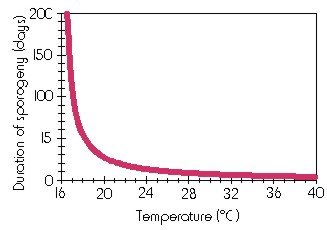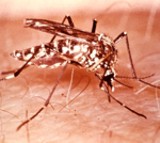Section 3: MALARIA & MODELLING

Biology
Contents:
B:
Malaria is caused by a type of parasite that is carried by a type of mosquito. The mosquito is the vector of the disease.
In total there are over 150 named species of the parasite Plasmodium, but only four of these species can transmit malaria to humans: P.falciparum (the most deadly) , P.vivax, P.ovale, and P.malariae.
Apart from P. malariae that can cause malaria in higher primates, these parasites can't cause malaria in animals, only in humans.
Animals can also get malaria but this is caused by other species of Plasmodium and these cannot cause malaria in humans.
The malaria parasite is transmitted to humans by mosquitos (it is transmitted when an infected mosquito bites a human). However, not all species of mosquito can carry the parasite responsible for causing malaria in humans.
The mosquitoes which can carry the malaria parasite are Anopheles species mosquitoes. There are about 400 species of this mosquito of which just over 40 species are important transmitters of the malaria parasite to humans.
The key mosquitoes for tropical Africa are Anopheles arabiensis, normally written A. arabiensis, A. funestus and A. gambiae .
Given the number of deaths annually, in excess of one million, caused through infectious mosquito bites, the Anopheles should earn the title of ‘the species which kills most people.' Sharks kill only 6 humans per year in comparison.
Click on picture to see a bigger version
Biology of the malaria parasite
The exact development of the parasite depends in part on the type of parasite. The diagram below shows the general development stages of the malaria parasite in both the vector (mosquito) and the host (human). Click on each red number to learn more.
.gif)
Even though the stages are numbered from one to seven, the cycle doesn't necessarily have to start at one. In fact stages 1 and 7 are the same (just different people). The mosquito bite at stage 1 is from a mosquito which has already been infected so stages 5 and 6 must have already happened due to biting an already infected human. But if we start at stage 5, the human needs to have already been infected so stages 1 - 4 must have already occurred. Which came first? It is a bit of a chicken and egg puzzle!
The development time in the human host is about two weeks and in the vector it depends on the temperature.

Source: MARA
This graph shows the relationship between the ambient temperature (oC) and the length of the sporogonic cycle (development of the parasite within the mosquito) in days.
The graph begins at 16oC as this is the lowest temperature at which parasite development takes place.
This relationship needs to be considered closely linked to the affect of temperature on mosquito survival (see the adult atage of the mosquito cycle below), as the mosquito needs to survive long enough for the sporogonic cycle to take place.
The ideal temperature is around 20oC and so sporogeny generally takes about 10 days.
Further details on this temperature dependence are discussed in the modelling section.
Only the female mosquitoes transmit malaria as only they need the blood meal for protein to allow them to develop their eggs.
The development cycle of the mosquito is called the gonotrophic cycle. There are four stages to this cycle: eggs, larvae, pupae and adults. (Click on each of these to see more details and images).
The time taken for the eggs to develop is dependent on temperature and is discussed further in the modelling section but is typically about three to four days.
The eggs are oviposited into water which can be anywhere from a bike tyre to an irrigated field or slow moving irrigation channel.
The egg development depends on the water temperature. The eggs mature and the mosquitoes emerge and the cycle begins again.
Old jars and cans filled with rain water provide breeding grounds for mosquitoes.

Mosquitoes are the vector for other important diseases that affect humans as well as malaria. These include:
- the West Nile Virus where the mosquitoes as the vectors include certain Aedes and Culex mosquito species;
- Dengue fever which is a virus spread by certain Aedes spp., particularly the Aedes aegypti mosquito;
- Yellow Fever is a virus spread by certain Aedes spp. mosquito and in urban areas predominately by Aedes aegypti;
- and for Rift Valley Fever the vectors are certain species of Aedes and Culex mosquitoes.
The picture on the left shows a female Aedes aegypti mosquito. This mosquito is a known transmitter of both Dengue fever, and yellow fever. In fact, A. aegypti is sometimes referred to as the “Yellow Fever Mosquito”. The viruses are transferred to the host when bitten by a female mosquito.
Of course mosquitoes are not the only insect or animal to carry diseases. You may wish to carry out your own research to see which other insects and animals may act as disease vectors.
The following 5 questions will test how much you've learned from what you've just read.









